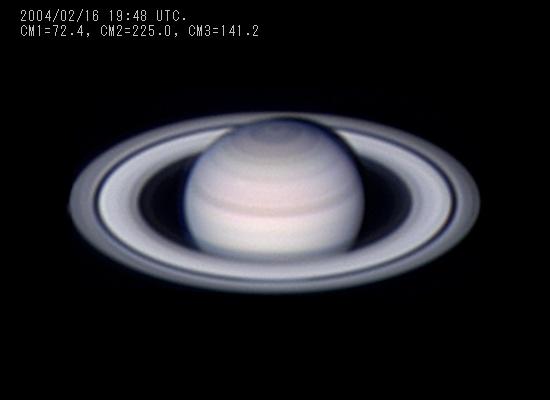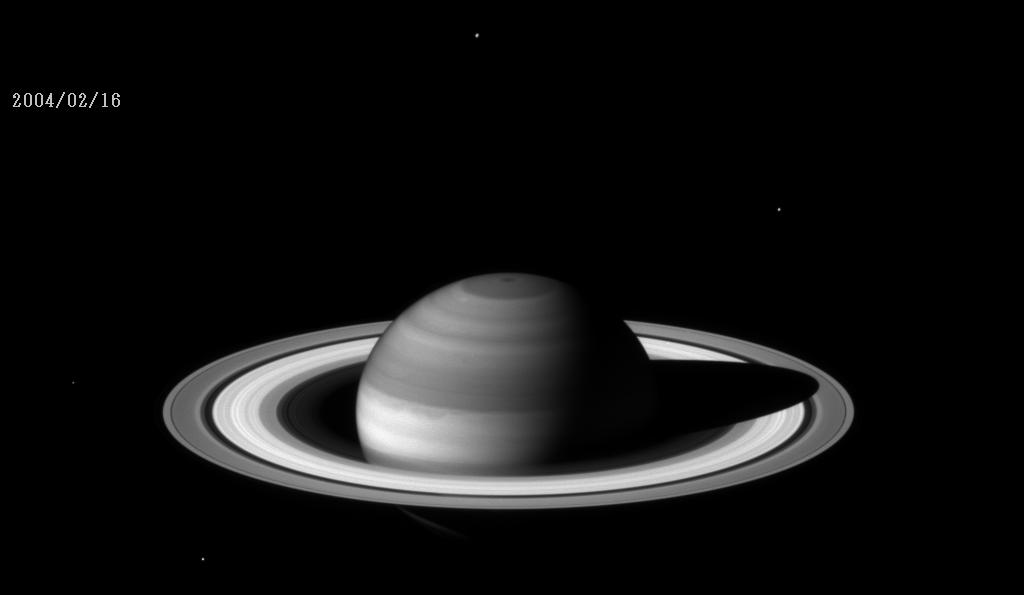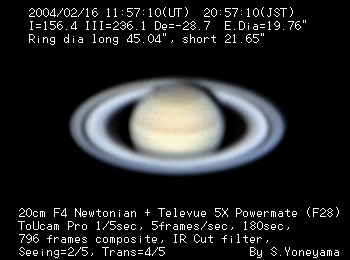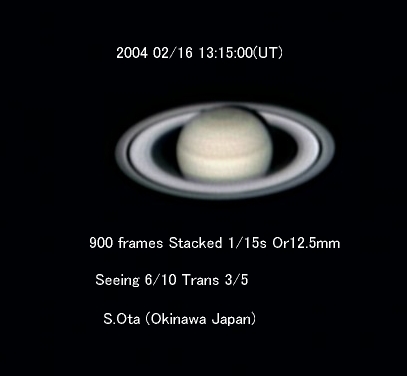|
Damian Peach (235mm Celestron SCT:Philips ToUcam Pro)
|
Hi all
Having been under a large high pressure system the past week i was hopefull of some good seeing
however the system turned out to be mostly cloudy (much to the anoyance of many here!.)
Last night however, as it moved away with a cold front approaching for the NW, the sky was clear
for a few hrs, and the seeing was good to excellent.
I attach the best Saturn image obtained at 19:48 UTC. CM1=72.4, CM2=225.0, CM3=141.2
 A 9.25" (23.5cm) Celestron SCT @ F/29.4 was used
in conjunction with an ATK-1HS camera. 2600 images (L) 800 images (RGB.)
A white spot at -41.1 was seen at L3=109.3.
A small white spot was captured at L3=109.
A 9.25" (23.5cm) Celestron SCT @ F/29.4 was used
in conjunction with an ATK-1HS camera. 2600 images (L) 800 images (RGB.)
A white spot at -41.1 was seen at L3=109.3.
A small white spot was captured at L3=109.
 9.25" (23.5 cm) Celestron SCT @ f/29.4 ATK-1HS CCD camera.
Seeing good-excellent (Pickering 7-9.) Transparency good (5.0mag) slight haze.
No wind. Heavy dew. Eq Diam=19.7" Altitude=50-61degs.
[Damian Peach: Loudwater, Buckinghamshire, UK.]
9.25" (23.5 cm) Celestron SCT @ f/29.4 ATK-1HS CCD camera.
Seeing good-excellent (Pickering 7-9.) Transparency good (5.0mag) slight haze.
No wind. Heavy dew. Eq Diam=19.7" Altitude=50-61degs.
[Damian Peach: Loudwater, Buckinghamshire, UK.]
|
|
The Cassini-Huygens mission
|
South up

Original image tiff 164kB 1024X1024
全容を明瞭に撮影するための特殊フィルターを使用して、 6610万km × 4110万km のスケールで2004/02/16に撮影された。
イメージスケールは、397km/pである。
MT2 スペクトルのフィルタは、メタンの 727 mμ波長の吸収帯の近赤外線の領域。
この様子では、メタンには水素が大気内で一様に混合している。暗部分は高い雲が少ない強いメタン吸収の強い場所である
明るい部分は、下層のメタンを覆う高い厚い雲がある場所である。
画像は、雲の高さの違いによってはっきりとした緯度帯のようになっており、赤道は高高度の厚い雲、極付近は比較的深部まで薄いかすみがあるようだ。
ちょうど赤道 ( HSTによって 1990 年代に継続的に撮影されたされたイメージ) の南半球では同様の大気の状態を示している。
土星の衛星 4 個が見えている。
左下 Enceladus 直径 499 km
左端 Mimas 直径 396 km
右上 Tethys 直径1060 km
上方 Rhea 直径1528 km
Mimas と Enceladus の輝度は強調してある。
The Cassini narrow angle camera took this image of Saturn on Feb. 16, 2004, from a distance of 66.1 million kilometers (41.1 million miles) in a special filter which reveals clouds and haze high in the atmosphere.
The image scale is 397 kilometers (247 miles) per pixel. The MT2 spectral filter samples a near-infrared region of the electromagnetic spectrum where methane gas absorbs light at a wavelength of 727 nanometers. In the image, methane gas is uniformly mixed with hydrogen, the main gas in Saturn's atmosphere. Dark locales are places of strong methane absorption, relatively free of high clouds; the bright areas are places with high, thick clouds which shield the methane below.
Image details reveal a high, thick equatorial cloud and a relatively deep or thin haze encircling the pole, as well as several distinct latitude bands with different cloud height attributes. It also shows a high atmospheric disturbance, just south of the equator, which has persisted throughout the 1990s in images returned by NASA's Hubble Space Telescope.
Four of Saturn's moons are visible (clockwise from above right): Enceladus (499 kilometers, or 310 miles across); Mimas (396 kilometers, or 245 miles across); Tethys (1,060 kilometers, or 659 miles across); and Rhea (1,528 kilometers, or 949 miles across). The imaging team enhanced the brightness of Mimas and Enceladus by a factor of three.
The Cassini-Huygens mission is a cooperative project of NASA, the European Space Agency and the Italian Space Agency. The Jet Propulsion Laboratory, a division of the California Institute of Technology in Pasadena, manages the Cassini mission for NASA's Office of Space Science, Washington, D.C. The imaging team is based at the Space Science Institute, Boulder, Colo.
For more information, about the Cassini-Huygens mission visit, http://saturn.jpl.nasa.gov and the Cassini imaging team home page, http://ciclops.org.
Image Credit:
NASA/JPL/Space Science Institute
----------------------------------------------------
GIF anime 2004/02/15 - 2004/02/19

Large size GIF anime 8.919 megabytes
Original Caption Released with Image:
Wind-blown clouds and haze high in Saturn's atmosphere are captured in a movie made from images taken by the Cassini narrow angle camera between Feb. 15 and Feb. 19, 2004.
The bright areas in these images represent high haze and clouds near the top of Saturn's troposphere. Cassini has three filters designed to sense different heights of clouds and haze in the planet's atmosphere. Any light detected by cameras using the 889-nanometer filter is reflected very high in the atmosphere, before the light is absorbed.
This is the first movie ever made showing Saturn in these near-infrared wavelengths. The images were made using a filter sensitive to a narrow range of wavelengths centered at 889-nanometers, where methane in Saturn's atmosphere absorbs sunlight.
In the movie, atmospheric motions can be seen most clearly in the equatorial region and at other southern latitudes. Saturn's equatorial region seems disturbed in the same way that it has been for the past decade, as revealed by observations from NASA's Hubble Space Telescope. Researchers have speculated that the bright cloud patterns there are associated with water-moist convection arising from a deeper atmospheric level where water condenses on Saturn, and rising to levels at or above the visible cloud tops. Close analysis of future data by scientists on the Cassini-Huygens mission should help determine whether this is the case.
Saturn's rings are extremely overexposed in these images. Because the range of wavelengths for this spectral filter is narrow, and because most of this light is absorbed by Saturn, the disc of Saturn is inherently faint and the exposures required are quite long (22 seconds). The rings do not strongly absorb at these wavelengths, so they reflect more light and are overexposed compared to the atmosphere. Orbiting moons in the images were manually removed during processing. The movie, consisting of 30 stacked images, spans five days and captures five complete but non-consecutive Saturn rotations. The direction of motion is from left to right. Each 10.6-hour Saturn rotation is evenly sampled by six images. After each rotation sequence, the planet can be seen to grow slightly in the field of view. Cassini was 65.6 million kilometers (40.7 million miles) from Saturn when the images, reduced in scale by a factor of two onboard the spacecraft, were taken. The resulting image scale is approximately 786 kilometers (420 miles) per pixel.
The Cassini-Huygens mission is a cooperative project of NASA, the European Space Agency and the Italian Space Agency. The Jet Propulsion Laboratory, a division of the California Institute of Technology in Pasadena, manages the Cassini-Huygens mission for NASA's Office of Space Science, Washington, D.C. The imaging team is based at the Space Science Institute, Boulder, Colorado.
Image Credit:
NASA/JPL/Space Science Institute
Image Note:
Meth44DAnim
[NASA/JPL/Space Science Institute]
 ALPO-Japan Latest ALPO-Japan Latest

 Saturn Section Saturn Section
|





A 9.25" (23.5cm) Celestron SCT @ F/29.4 was used in conjunction with an ATK-1HS camera. 2600 images (L) 800 images (RGB.) A white spot at -41.1 was seen at L3=109.3. A small white spot was captured at L3=109.
9.25" (23.5 cm) Celestron SCT @ f/29.4 ATK-1HS CCD camera. Seeing good-excellent (Pickering 7-9.) Transparency good (5.0mag) slight haze. No wind. Heavy dew. Eq Diam=19.7" Altitude=50-61degs. [Damian Peach: Loudwater, Buckinghamshire, UK.]


 ALPO-Japan Latest
ALPO-Japan Latest

 Saturn Section
Saturn Section